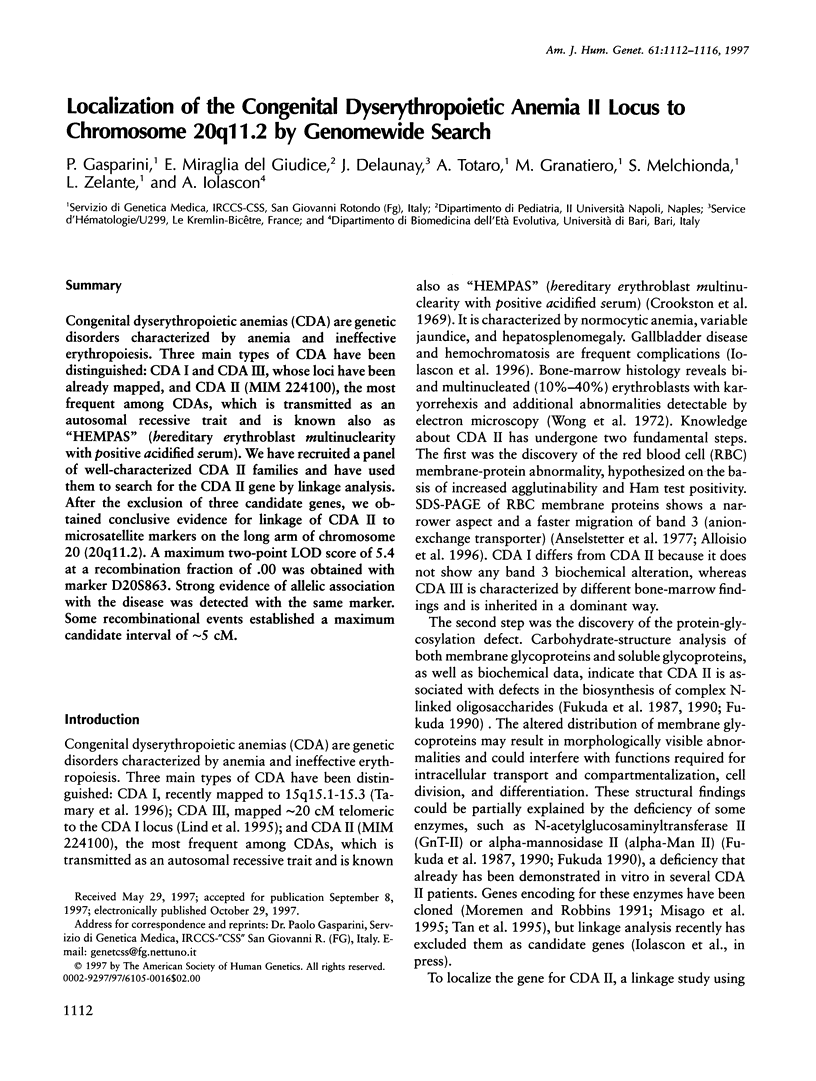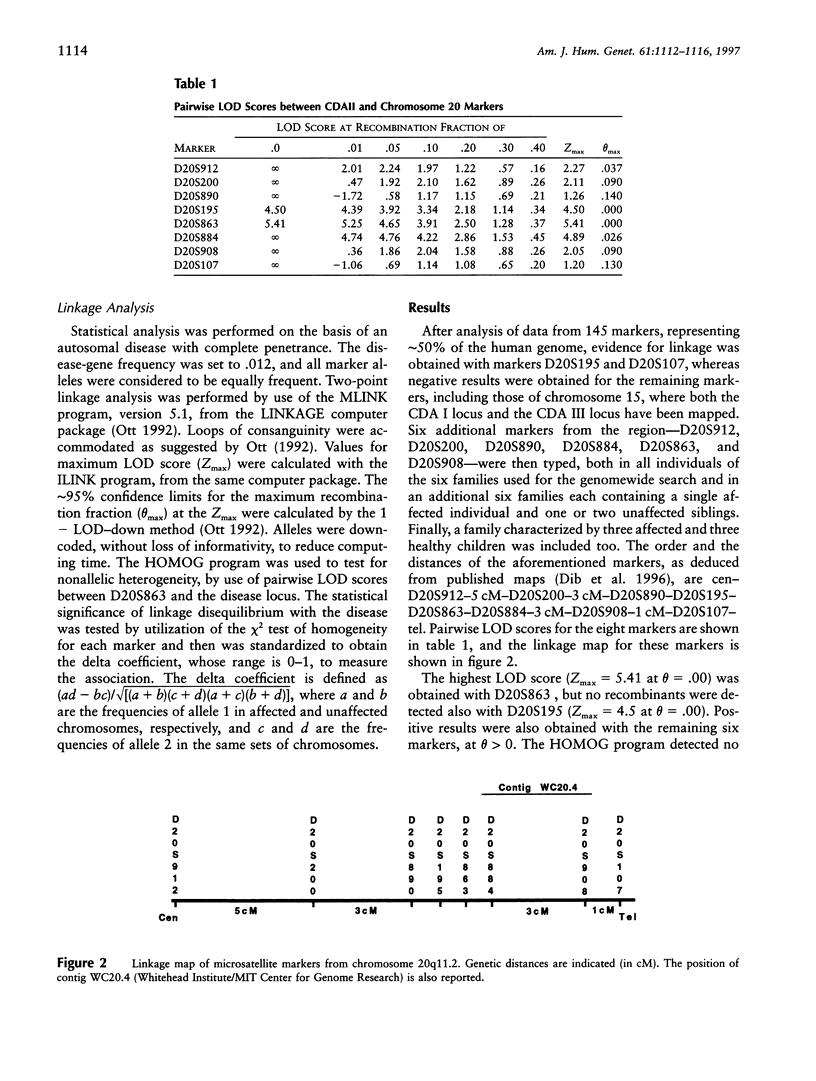Abstract
Congenital dyserythropoietic anemias (CDA) are genetic disorders characterized by anemia and ineffective erythropoiesis. Three main types of CDA have been distinguished: CDA I and CDA III, whose loci have been already mapped, and CDA II (MIM 224100), the most frequent among CDAs, which is transmitted as an autosomal recessive trait and is known also as "HEMPAS" (hereditary erythroblast multinuclearity with positive acidified serum). We have recruited a panel of well-characterized CDA II families and have used them to search for the CDA II gene by linkage analysis. After the exclusion of three candidate genes, we ob-tained conclusive evidence for linkage of CDA II to microsatellite markers on the long arm of chromosome 20 (20q11.2). A maximum two-point LOD score of 5.4 at a recombination fraction of .00 was obtained with marker D20S863. Strong evidence of allelic association with the disease was detected with the same marker. Some recombinational events established a maximum candidate interval of approximately 5 cM.
Full text
PDF




Selected References
These references are in PubMed. This may not be the complete list of references from this article.
- Alloisio N., Texier P., Denoroy L., Berger C., Miraglia del Giudice E., Perrotta S., Iolascon A., Gilsanz F., Berger G., Guichard J. The cisternae decorating the red blood cell membrane in congenital dyserythropoietic anemia (type II) originate from the endoplasmic reticulum. Blood. 1996 May 15;87(10):4433–4439. [PubMed] [Google Scholar]
- Anselstetter V., Horstmann H. J., Heimpel H. Congenital dyserythropoietic anaemia, types I and II: aberrant pattern of erythrocyte membrane proteins in CDA II, as revealed by two-dimensional polyacrylamide gel electrophoresis. Br J Haematol. 1977 Feb;35(2):209–215. doi: 10.1111/j.1365-2141.1977.tb00577.x. [DOI] [PubMed] [Google Scholar]
- Crookston J. H., Crookston M. C., Burnie K. L., Francombe W. H., Dacie J. V., Davis J. A., Lewis S. M. Hereditary erythroblastic multinuclearity associated with a positive acidified-serum test: a type of congenital dyserythropoietic anaemia. Br J Haematol. 1969 Jul;17(1):11–26. doi: 10.1111/j.1365-2141.1969.tb05660.x. [DOI] [PubMed] [Google Scholar]
- Dib C., Fauré S., Fizames C., Samson D., Drouot N., Vignal A., Millasseau P., Marc S., Hazan J., Seboun E. A comprehensive genetic map of the human genome based on 5,264 microsatellites. Nature. 1996 Mar 14;380(6570):152–154. doi: 10.1038/380152a0. [DOI] [PubMed] [Google Scholar]
- Fukuda M. N., Dell A., Scartezzini P. Primary defect of congenital dyserythropoietic anemia type II. Failure in glycosylation of erythrocyte lactosaminoglycan proteins caused by lowered N-acetylglucosaminyltransferase II. J Biol Chem. 1987 May 25;262(15):7195–7206. [PubMed] [Google Scholar]
- Fukuda M. N. HEMPAS disease: genetic defect of glycosylation. Glycobiology. 1990 Sep;1(1):9–15. doi: 10.1093/glycob/1.1.9. [DOI] [PubMed] [Google Scholar]
- Fukuda M. N., Masri K. A., Dell A., Luzzatto L., Moremen K. W. Incomplete synthesis of N-glycans in congenital dyserythropoietic anemia type II caused by a defect in the gene encoding alpha-mannosidase II. Proc Natl Acad Sci U S A. 1990 Oct;87(19):7443–7447. doi: 10.1073/pnas.87.19.7443. [DOI] [PMC free article] [PubMed] [Google Scholar]
- Gyapay G., Morissette J., Vignal A., Dib C., Fizames C., Millasseau P., Marc S., Bernardi G., Lathrop M., Weissenbach J. The 1993-94 Généthon human genetic linkage map. Nat Genet. 1994 Jun;7(2 Spec No):246–339. doi: 10.1038/ng0694supp-246. [DOI] [PubMed] [Google Scholar]
- Iolascon A., D'Agostaro G., Perrotta S., Izzo P., Tavano R., Miraglia del Giudice B. Congenital dyserythropoietic anemia type II: molecular basis and clinical aspects. Haematologica. 1996 Nov-Dec;81(6):543–559. [PubMed] [Google Scholar]
- Lind L., Sandström H., Wahlin A., Eriksson M., Nilsson-Sojka B., Sikström C., Holmgren G. Localization of the gene for congenital dyserythropoietic anemia type III, CDAN3, to chromosome 15q21-q25. Hum Mol Genet. 1995 Jan;4(1):109–112. doi: 10.1093/hmg/4.1.109. [DOI] [PubMed] [Google Scholar]
- Misago M., Liao Y. F., Kudo S., Eto S., Mattei M. G., Moremen K. W., Fukuda M. N. Molecular cloning and expression of cDNAs encoding human alpha-mannosidase II and a previously unrecognized alpha-mannosidase IIx isozyme. Proc Natl Acad Sci U S A. 1995 Dec 5;92(25):11766–11770. doi: 10.1073/pnas.92.25.11766. [DOI] [PMC free article] [PubMed] [Google Scholar]
- Moremen K. W., Robbins P. W. Isolation, characterization, and expression of cDNAs encoding murine alpha-mannosidase II, a Golgi enzyme that controls conversion of high mannose to complex N-glycans. J Cell Biol. 1991 Dec;115(6):1521–1534. doi: 10.1083/jcb.115.6.1521. [DOI] [PMC free article] [PubMed] [Google Scholar]
- Tan J., D'Agostaro A. F., Bendiak B., Reck F., Sarkar M., Squire J. A., Leong P., Schachter H. The human UDP-N-acetylglucosamine: alpha-6-D-mannoside-beta-1,2- N-acetylglucosaminyltransferase II gene (MGAT2). Cloning of genomic DNA, localization to chromosome 14q21, expression in insect cells and purification of the recombinant protein. Eur J Biochem. 1995 Jul 15;231(2):317–328. doi: 10.1111/j.1432-1033.1995.tb20703.x. [DOI] [PubMed] [Google Scholar]
- Wong K. Y., Hug G., Lampkin B. C. Congenital dyserythropoietic anemia type II: ultrastructural and radioautographic studies of blood and bone marrow. Blood. 1972 Jan;39(1):23–30. [PubMed] [Google Scholar]


